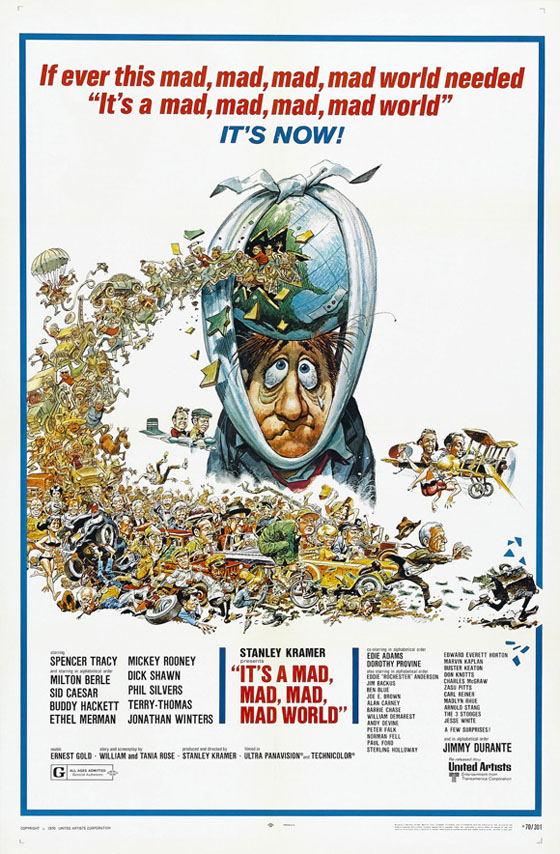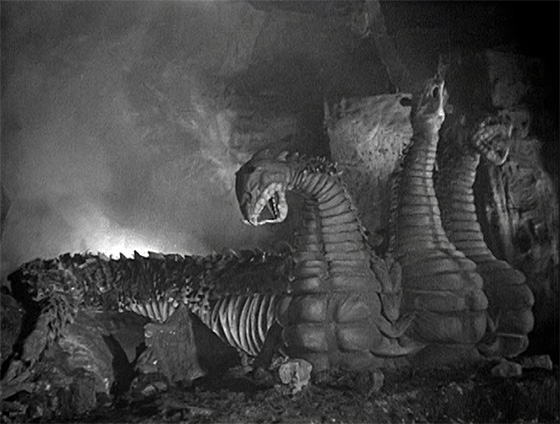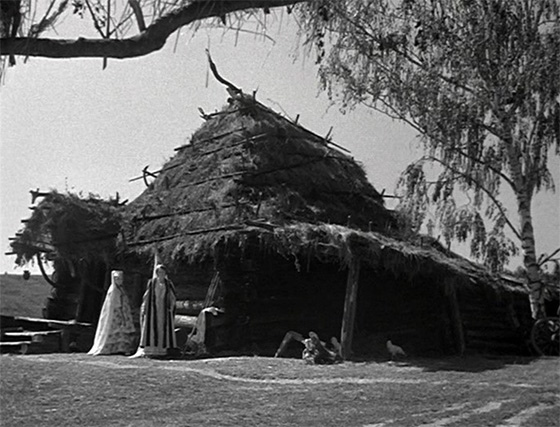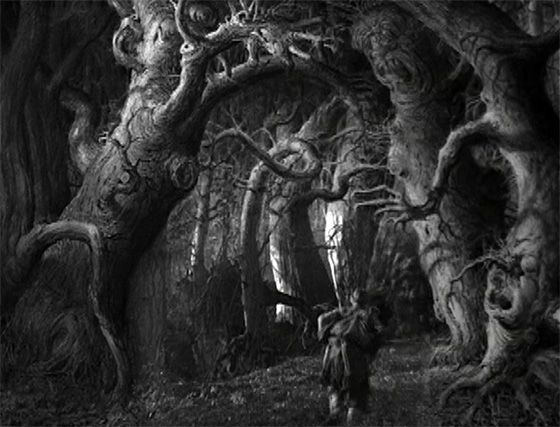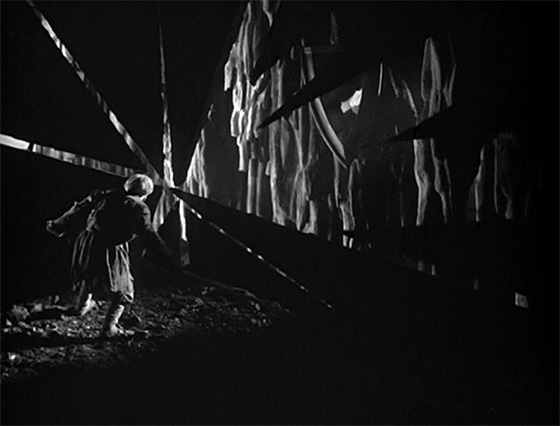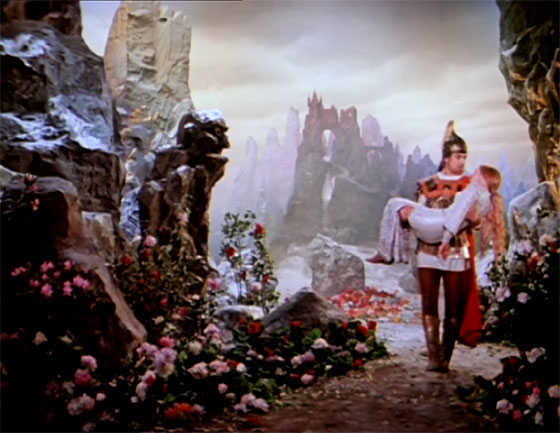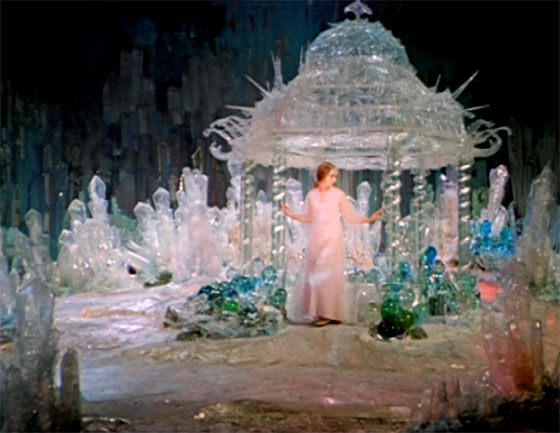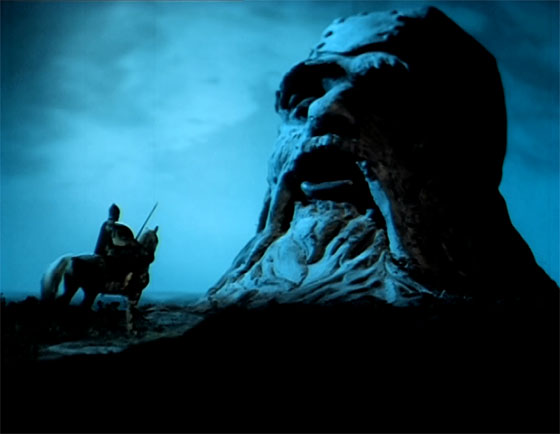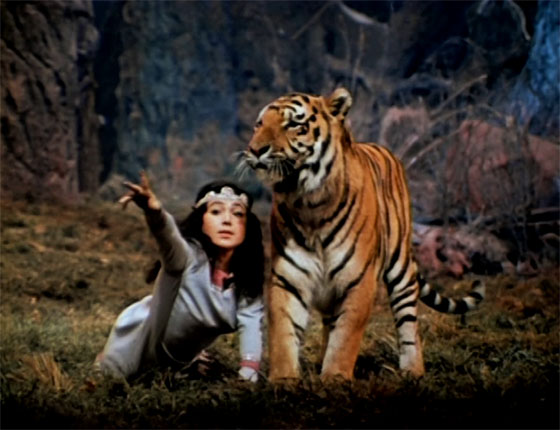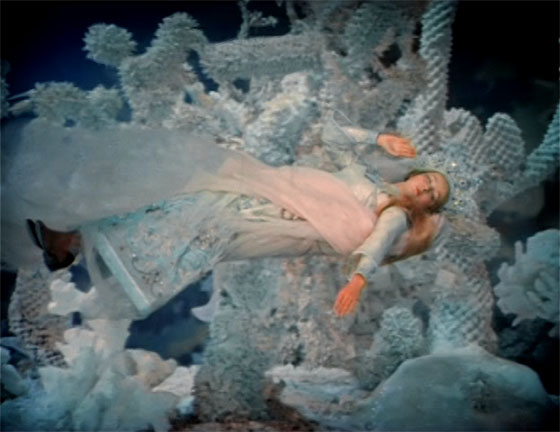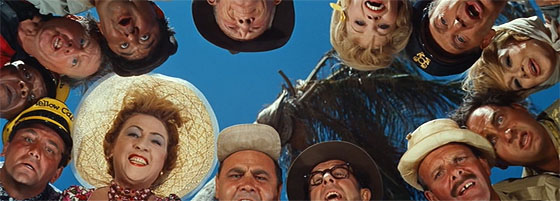
It’s often said that the ideal running time for a comedy is about 90 minutes – any more, and the audience gets tired of laughing. Much of the works of Mel Brooks, Woody Allen, and Monty Python adhere to that guideline, but of course It’s a Mad, Mad, Mad, Mad World (1963) flaunts its running time, which in its initial road-show run was a marathon 202 minutes, audience’s strained cheeks be damned. This was a comedy spectacle, shot in 70mm and projected on curved Cinerama screens to plunge audiences into the center of the cast’s race to find $350,000 in stolen cash. The running time was reduced to 163 minutes for its later general release, toward the purpose of allowing theaters to squeeze more screenings into a day. And you could easily cut the film down further – you could slash it down to 90 minutes, keep the entire plot, and the film might work better as a comedy machine, but it would lose something, too. The film is too long, too ambitious, too everything, but that’s the whole point of the enterprise. Director Stanley Kramer declared he was going to make “the comedy to end all comedies.” He wasn’t known for comedy, but he was known for taking himself and his carefully chosen subject matter very seriously (The Defiant Ones, On the Beach, Judgment at Nuremberg, etc.). Such a statement suggested that perhaps he was taking comedy too seriously. But his experiment, doomed to fail, is so much fun anyway because he drops into the soup everything that had heretofore been labeled Comedy. It’s a history of small-and-silver-screen comedy from the silent era to the Golden Age of TV through to the latest hit comedy records of the early 60’s – and, in that respect, the film is pretty compact, and a bargain. You could cut the film, because there’s no shortage of extraneous characters, but you’d lose cameos from many comedy legends (already, the general release print leaves most of Buster Keaton on the cutting-room floor). The joy of watching It’s a Mad, Mad, Mad, Mad World is reveling in its sloppiness, its excess, and its many, many familiar faces, everyone doing their thing, even if it’s for a few seconds. This sort of filmmaking would get old fast – all-star comedy cavalcades became the rage for the 60’s, and were almost always a mixed bag – but for now it felt very fresh, and though it’s ostensibly a film about greed, it’s a downright cheerful treatise (perhaps it’s that wonderful, carousel-like score by Ernest Gold). Today, when you throw on It’s a Mad, Mad, Mad, Mad World, it’s because you want to spend the evening – the whole evening – in the pleasant company of great comedians. The film is a service.
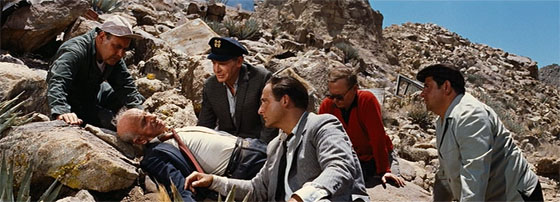
Jimmy Durante, about to kick the bucket, delivers his dying words to Jonathan Winters, Milton Berle, Sid Caesar, Mickey Rooney, and Buddy Hackett.
The film doesn’t feel quite as long as it is because the simple plot is in the form of a race. This is a sporting event. Even Spencer Tracy, as Captain T.G. Culpepper, starts placing bets with his fellow officers while tracking the group’s mad, mad dash across the California desert; in one of the film’s funniest scenes, when he suggests they help two of these players escape from the locked basement of a hardware store, one of his officers objects: “That’s not fair to the others…they got themselves in, they should get themselves out.” The audience is invited to be spectators and place bets of their own on who will make it to Santa Rosita, CA first. And the possibilities keep expanding: at the start, when a dying gangster (Jimmy Durante) tells of a treasure buried for fifteen years under “a big dubba-yah,” the only witnesses are Jonathan Winters, Milton Berle, Sid Caesar, Mickey Rooney, and Buddy Hackett, as well as long-suffering wives Edie Adams (The Ernie Kovacs Show) and Dorothy Provine (The Alaskans), and the suffer-causing Mrs. Marcus (Ethel Merman). But after the group decides they can’t share the cash, they embark on a race that gradually encompasses more and more participants (including Phil Silvers, Terry-Thomas, Dick Shawn, Peter Falk, and Eddie “Rochester” Anderson of The Jack Benny Program). Along the way they encounter an endless parade of recognizable faces: Don Knotts, Jim Backus, Carl Reiner, Jerry Lewis, Andy Devine, Jack Benny, Stan Freberg, Arnold Stang, The Three Stooges, and more. Because so many of these comedians worked on the small screen (or radio, or comedy albums), younger audiences are less likely to recognize many of them; but that also makes the film more fascinating and valuable. This is a rare chance to enjoy Sid Caesar, one of the greats of TV comedy, in a starring role in a motion picture; one of his finest moments in the film is his diplomatic explanation of how each share should be divided, mathematics that grow increasingly complicated to meet everyone’s demands – here, as in his later scenes in the hardware store basement, Caesar essays the patient, reasonable man who is driven round the bend by a world that refuses to cooperate.
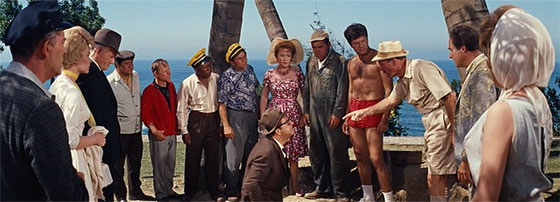
70mm widescreen under the Big "W": Milton Berle, Dorothy Provine, Spencer Tracy, Buddy Hackett, Mickey Rooney, Eddie “Rochester” Anderson, Peter Falk, Phil Silvers, Ethel Merman, Jonathan Winters, Dick Shawn, Terry-Thomas, Sid Caesar, Edie Adams.
If the race were actually who’s going to steal the show first, a late-arriving Phil Silvers surely gets to the front of the pack fast. The scheming Sgt. Bilko of The Phil Silvers Show – which had already been off the air for four years – Silvers is immensely appealing as the most amoral con artist of Mad World‘s motley crew, at one point casually threatening a small child’s life (to the kid’s credit, he then leads Silvers and his car straight into a deep river). Most of the cast is playing a variation on their famous personae, including Merman as the most monstrous mother-in-law ever filmed. Happily, Kramer allows the audience to indulge in schadenfreude with Merman’s character every twenty minutes or so, rather than saving it all up for a big comeuppance at the end (though she gets it then, too). Berle goes a little against type playing a pill-popping milquetoast, and Winters, who could play the whole cast in a radio adaptation, settles for an overgrown innocent with the propensity to rampage like the Frankenstein Monster. (It’s wonderful to see Winters’ laid-back improv energy up against Dick Shawn’s manic beatnik: “Man, you’re buggin’ me, you’re buggin’ me!” Shawn barks, and Winters mutters, “What’re you talkin’ about, buggin‘?”) Winters demonstrates the film’s style of comedy most directly in a sequence in which he tears a desert gas station down to the ground one piece at a time, terrorizing its two nebbish attendants (Arnold Stang and Marvin Kaplan). If you don’t find that scene funny, this movie’s not for you, because there’s two more hours of chaotic slapstick on the way. But there’s a grace to the action, just like when the all-star cast is flung to and fro from an out-of-control firetruck ladder in the film’s cartoonish climax, or in every scene in which cars go airborne or take dizzying U-turns, or when Rooney and Hackett fly a plane through a billboard and an airport hangar (the stunts in this film rival a Bond movie). The posters featured art by MAD Magazine‘s Jack Davis, and for once a film matches up perfectly with its advertising: this is MAD writ (Cinerama-)large.
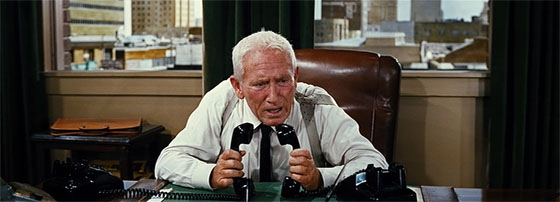
Tracy as the frazzled Captain Culpepper.
The new Criterion Collection Blu-Ray/DVD combo edition is as close to a definitive treatment as we’re going to get for the time being. The film is presented in two versions: the widely-circulated, 163-minute general release version of the film, as well as a new 197-minute extended edition, which comes damn close to restoring the film to its original road-show length of 202 minutes. (Sadly, the original cut of the film has been lost, making a full HD version of the road-show edition impossible for the time being.) Restored by Robert A. Harris, this epic cut contains scenes which were previously released in the extended version issued in the early 90’s on VHS (and are very familiar to me, since I watched that 2-tape set many times), as well as more material recently scavenged: some scenes are only in audio with stills substituted to approximate the action, others sections have dropped audio and rely (fleetingly) on subtitles, and all the restored footage is inferior in quality to the general-release material. Still, the advantage of the longer version is that plot points are made clearer and the comic rhythms of each scene are left untruncated. Also restored is the full intermission, which includes police dispatches updating the audience (those who didn’t go out to the lobby to smoke, as the theme music politely suggested) on the activities and whereabouts of the characters. Even these bits of ephemera have some funny little gags (I particularly enjoyed getting reports on Phil Silvers’ declining relationship with the kid). A broad collection of supplements have been gathered here, including a fascinating two-part Canadian television special on the film’s press junket and premiere. Shot in something close to cinéma vérité, we’re allowed to mingle with the celebrities while they duel with journalists, try to make each other laugh, and deal with mysterious conflicts that are presented completely free of context. We see Winters distracting the reporters with his character voices, until he gets bored and wanders off. We see Rooney enthusiastically signing every last autograph, Silvers and Terry-Thomas chit-chatting with their wives, and even a young Marni Nixon. And there’s Stanley Kramer, looking either distracted or depressed after the premiere has ended. While a friend tells him how much she liked the film and what a great party it is, he mumbles over and over that he’s lived with the film so long, he doesn’t know what’s funny anymore. Any artist can relate to the sentiment, but Kramer should be relieved to know that even though his film didn’t “end all comedies,” it holds up 51 years on, and it’s still funny.
